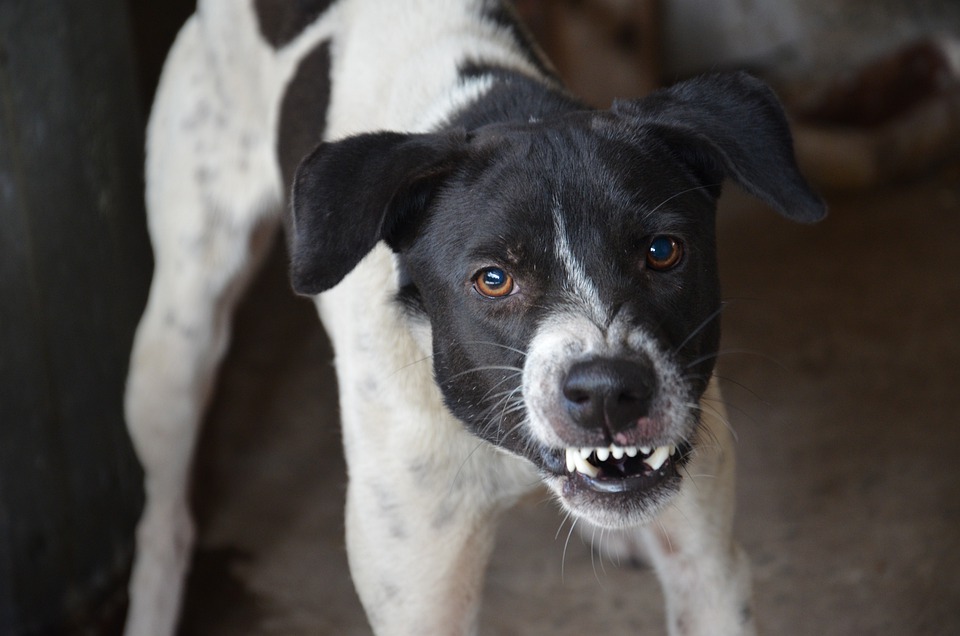Lunging, biting, snapping, growling, snarling – even giving you the stink eye – these aggressive behaviors can be startling and frightening when your dog is normally gentle and tame. So how worried should you be? That depends on the cause of the aggression. It may take a little bit of observation and discussion with your vet to figure out the root cause, but we’ve put together a list of nine common reasons for aggressive behavior to help you on your search.

(Pixabay / simonocampo999)
1. Being a Grump
Everyone is allowed to be a grump every once in a while – no matter if they’re human or animals. As a human, sometimes other people just push your buttons, causing you to snap at them even if you don’t necessarily mean to.
Dogs are the same way. Perhaps an overactive new puppy has tried the patience of an older dog, or maybe small children invaded a dog’s space a little too much for one day – these things can make dogs temporarily more grumpy than usual. And unfortunately, grumpiness tends to manifest as aggression.
2. Fear
Fear is another major player in the aggression game. When dogs are afraid, they sometimes act aggressively as a way of preparing themselves to either fight or run away. Your dog could be frightened of loud noises, certain types of people, or specific smells. Fido might also be picking up on your social and emotional cues and responding aggressively because you’re angry or fearful.
3. Puppyhood
Dogs that are rescue animals sometimes have a traumatic puppyhood that can make them aggressive later in life. If they’ve lived through neglect, abuse, or a lack of socialization, they could act out because that is the way they learned how to regulate their feelings of uncertainty as a puppy. If this is the case for your pup, don’t give up hope! Dog behavior training can help curb those basic impulses and teach your dog to let off steam safely and productively.
4. Dislike of other Animals
There’s a quote: “Quit trying to make everyone like you – YOU don’t even like everyone.” While dogs are usually quicker to forgive than most people, sometimes they just don’t like certain other animals. It could be cats, birds, or other dogs, but sometimes it’s small children or specific demographics of people. In those circumstances, professional dog training may be in order to keep everyone safe.
5. Injury or Sickness
We all sometimes wish that our dogs could talk and tell us what’s right and wrong in their lives, but unfortunately that’s not the case. When a dog acts out aggressively with little warning, it could be that he is sick or injured. Once you feel safe, do a quick physical check of your dog. Gently touch him to see if there are any sensitive places, and check inside his mouth to ensure that nothing is stuck or inflamed.
If you notice that your dog is hurt, follow these first aid procedures and take him to a vet as necessary.
External injuries are easier to see, so when an injury or sickness is hidden from view, it can cause aggression that seems unexplainable. Tumors, internal bleeding, arthritis, bone fractures, cognitive dysfunction, ear infections, and toothaches are all things that you may need a vet to diagnose. Pay attention to the circumstances around the aggression, so you can tell the vet and hopefully narrow down the cause.
6. Anxiety
Dogs can feel anxious when there are a lot of changes in the home, and they may act out aggressively even though they are usually very even-tempered. Things like a move, a new baby, or a new pet can all cause anxiety that can lead to aggression. If your dog is overly anxious, you may want to speak with your vet about anxiety-reducing supplements.
7. Possessive or Territorial
Most people want their dogs to be a little territorial so that the dog doesn’t welcome a burglar into the home and lead him to the family jewels. When dogs get overly possessive or territorial within the home or when taking a walk on a leash, it can become a safety issue. Professional dog training can help your dog learn how to share items and spaces so that everyone can have a fun time.
8. Frustration
Dogs – like humans – often act aggressively when overly frustrated. For dogs, though, frustration-aggression usually manifests after being chained up for extended periods of time or having a yard with a chain-link fence. They see so many fun things to do, and the frustration of not being able to do them can result in aggressive behavior. If you find that your dog is more aggressive after spending a lot of time in the backyard, you might want to go on more walks to help him feel liberated.
9. Dominance
Dogs are pack animals, meaning that they have a highly evolved hierarchy among themselves. There might be a little bit of “social aggression” if they meet new dogs and try to figure out the new hierarchy, but it usually passes quickly.
Remember, aggression is a behavior – not a trait – and how you address the aggression can make it more or less engrained in their personality. If you need help, contact Coddled Critters for some canine training to redirect aggression into positive behaviors instead.
